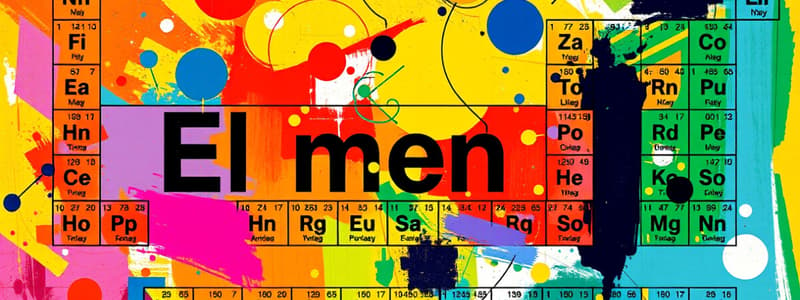Podcast
Questions and Answers
Name the family with the following elements: Lithium (Li), Sodium (Na), Potassium (K), Rubidium (Rb), Cesium (Cs) and Francium (Fr).
Name the family with the following elements: Lithium (Li), Sodium (Na), Potassium (K), Rubidium (Rb), Cesium (Cs) and Francium (Fr).
Alkali Metals
Name the family with the following elements: Beryllium (Be), Magnesium (Mg), Calcium (Ca), Strontium (Sr), Barium (Ba), and Radium (Ra).
Name the family with the following elements: Beryllium (Be), Magnesium (Mg), Calcium (Ca), Strontium (Sr), Barium (Ba), and Radium (Ra).
Alkaline Earth Metals
Name the family with some of the following elements: Scandium (Sc), Titanium (Ti), Vanadium (V), Chromium (Cr), Manganese (Mn), etc.
Name the family with some of the following elements: Scandium (Sc), Titanium (Ti), Vanadium (V), Chromium (Cr), Manganese (Mn), etc.
Transition Metals
Name the family with some of the following elements: Gallium (Ga), Indium (In), Tin (Sn), Lead (Pb), Bismuth (Bi), etc.
Name the family with some of the following elements: Gallium (Ga), Indium (In), Tin (Sn), Lead (Pb), Bismuth (Bi), etc.
Name the family with some of the following elements: Boron (B), Silicon (Si), Arsenic (As), Tellurium (Te), Polonium (Po), etc.
Name the family with some of the following elements: Boron (B), Silicon (Si), Arsenic (As), Tellurium (Te), Polonium (Po), etc.
Name the family with the following elements: Carbon (C), Hydrogen (H), Nitrogen (N), Oxygen (O), Phosphorus (P), Sulfur (S), and Selenium (Se).
Name the family with the following elements: Carbon (C), Hydrogen (H), Nitrogen (N), Oxygen (O), Phosphorus (P), Sulfur (S), and Selenium (Se).
Name the family with some of the following elements: Fluorine (F), Chlorine (Cl), Bromine (Br), Iodine (I), Astatine (At), etc.
Name the family with some of the following elements: Fluorine (F), Chlorine (Cl), Bromine (Br), Iodine (I), Astatine (At), etc.
Name the family with some of the following elements: Helium (He), Neon (Ne), Argon (Ar), Krypton (Kr), Xenon (Xe), Radon (Rn), etc.
Name the family with some of the following elements: Helium (He), Neon (Ne), Argon (Ar), Krypton (Kr), Xenon (Xe), Radon (Rn), etc.
Name the family with some of the following elements: Lanthanum (La), Cerium (Ce), Praseodymium (Pr), Neodymium (Nd), Promethium (Pm), etc.
Name the family with some of the following elements: Lanthanum (La), Cerium (Ce), Praseodymium (Pr), Neodymium (Nd), Promethium (Pm), etc.
Name the family with some of the following elements: Actinium (Ac), Thorium (Th), Protactinium (Pa), Uranium (U), Neptunium (Np), etc.
Name the family with some of the following elements: Actinium (Ac), Thorium (Th), Protactinium (Pa), Uranium (U), Neptunium (Np), etc.
Name some physical characteristics of the Alkali Earth Metals.
Name some physical characteristics of the Alkali Earth Metals.
Name some chemical characteristics of the Alkali Earth Metals.
Name some chemical characteristics of the Alkali Earth Metals.
Name some physical characteristics of the Alkaline Earth Metals.
Name some physical characteristics of the Alkaline Earth Metals.
Name some chemical characteristics of the Alkaline Earth Metals.
Name some chemical characteristics of the Alkaline Earth Metals.
Name some physical characteristics of the Transition Metals.
Name some physical characteristics of the Transition Metals.
Name some chemical characteristics of the Transition Metals.
Name some chemical characteristics of the Transition Metals.
Name some physical characteristics of the Post-Transition Metals.
Name some physical characteristics of the Post-Transition Metals.
Name some chemical characteristics of the Post-Transition Metals.
Name some chemical characteristics of the Post-Transition Metals.
Name some physical characteristics of the Metalloids.
Name some physical characteristics of the Metalloids.
Name some chemical characteristics of the Metalloids.
Name some chemical characteristics of the Metalloids.
Name some physical characteristics of the Non-Metals.
Name some physical characteristics of the Non-Metals.
Name some chemical characteristics of the Non-Metals.
Name some chemical characteristics of the Non-Metals.
Flashcards are hidden until you start studying
Study Notes
Element Families
- Alkali Metals: Includes Lithium (Li), Sodium (Na), Potassium (K), Rubidium (Rb), Cesium (Cs), Francium (Fr).
- Alkaline Earth Metals: Contains Beryllium (Be), Magnesium (Mg), Calcium (Ca), Strontium (Sr), Barium (Ba), Radium (Ra).
- Transition Metals: Comprises Scandium (Sc), Titanium (Ti), Vanadium (V), Chromium (Cr), Manganese (Mn).
- Post-Transition Metals: Features elements like Gallium (Ga), Indium (In), Tin (Sn), Lead (Pb), Bismuth (Bi).
- Metalloids: Includes Boron (B), Silicon (Si), Arsenic (As), Tellurium (Te), Polonium (Po).
- Non-Metals: Contains Carbon (C), Hydrogen (H), Nitrogen (N), Oxygen (O), Phosphorus (P), Sulfur (S), Selenium (Se).
- Halogens: Features Fluorine (F), Chlorine (Cl), Bromine (Br), Iodine (I), Astatine (At).
- Noble Gases: Comprises Helium (He), Neon (Ne), Argon (Ar), Krypton (Kr), Xenon (Xe), Radon (Rn).
- Rare Earth Lanthanides: Includes Lanthanum (La), Cerium (Ce), Praseodymium (Pr), Neodymium (Nd), Promethium (Pm).
- Rare Earth Actinides: Contains Actinium (Ac), Thorium (Th), Protactinium (Pa), Uranium (U), Neptunium (Np).
Physical Characteristics
- Alkali Metals: Soft, silvery/white, good conductors of heat/electricity.
- Alkaline Earth Metals: Similar to Alkali Metals; also soft, silvery/white, conductive.
- Transition Metals: Brightly colored elements/compounds, excellent conductors, malleable, highest average densities.
- Post-Transition Metals: Poor conductors, lower melting/boiling points than Transition Metals, weaker mechanical strength.
- Metalloids: Brittle, can appear shiny/dull, ductile or malleable, used as semiconductors.
- Non-Metals: Brittle, dull with no luster, not ductile/malleable, poor conductors; crucial in organic compounds.
Chemical Characteristics
- Alkali Metals: Most reactive, always bonded in nature, react violently with water, lose 1 electron to form cations.
- Alkaline Earth Metals: Reactive, less so than Alkali Metals, have 2 valence electrons, lose 2 electrons when bonding.
- Transition Metals: Typically have 1 or 2 valence electrons, pool electrons when bonding, least reactive of metals.
- Post-Transition Metals: Located in groups 13-16, have 3-6 valence electrons, tend to form anions.
- Metalloids: Exhibit properties of both metals and nonmetals, bond primarily like nonmetals.
- Non-Metals: Have 3-6 valence electrons, generally gain electrons when bonding.
Studying That Suits You
Use AI to generate personalized quizzes and flashcards to suit your learning preferences.



